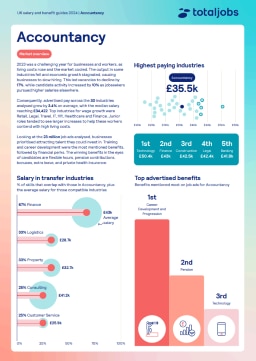
Hiring Trends Index: a look at the recruitment landscape of Q3 2024
Table of Contents
- Market overview
- Top takeaways
- The last three months
- Recruitment in Q4 2024
- The productivity conundrum
- Addressing productivity

Q3 2024 Hiring Trends Index Factsheet
The Q3 edition of our Hiring Trends Index takes an in-depth look at insights from 1,000 HR decision-makers. Along with the latest recruitment trends, and a forecast for the remainder of 2024, this instalment looks at workplace productivity and the steps businesses are taking to address this challenge.
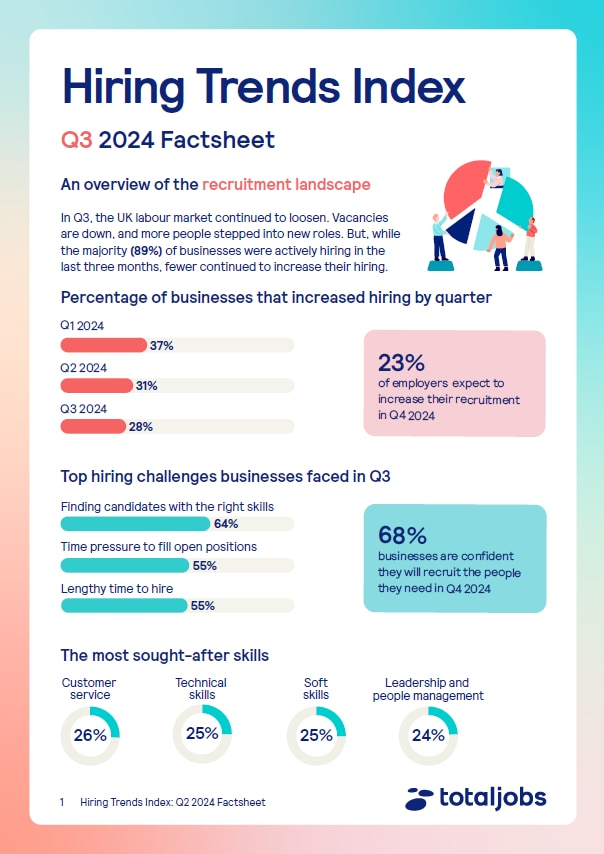
Hiring Trends Index Q3 2024 Factsheet
Hiring Trends Index — market overview
The UK labour market has been loosening in recent months, with vacancy numbers steadily declining and more people joining the workforce. Yet, despite the increase in candidate activity, employers continue to struggle to find the skilled talent they need.
The backdrop of this is that, in the first half of 2024, the UK economy began to improve, with a better-than-expected GDP growth of +0.7% in Q1 and +0.5% in Q2.
In terms of employment, the Office for National Statistics (ONS) reported that vacancies in the UK stood at 841,000 between July and September 2024—a decrease of almost 4% from the previous quarter. And although vacancies remain 5.6% higher than pre-pandemic levels, they are down by 14.4% compared to the same period last year.
Our data supports this trend, showing that while 9 in 10 companies (89%) were actively recruiting in Q3—up from 85% in Q2—fewer employers increased their hiring efforts, with only 28% ramping up recruitment, down from 31% in the previous quarter.
With the new Labour government prioritising economic growth and, which has made economic growth a key priority, preparing to announce the Autumn Budget at the end of October, the tone being set by policymakers has veered from cautious to sombre.
So, even as the economy shows signs of growth, businesses appear to be waiting for policy direction before scaling their teams.
Top takeaways from the Hiring Trends Index Q3 2024
- 89% of businesses actively recruited in Q3 2024, up from 80% in the same quarter of 2023.
- However, only 28% of employers increased their hiring in Q3 2024, a decrease from 31% in Q2 and 37% in Q1 2024.
- The average time to hire was 4.8 weeks, with businesses of over 500 employees taking 5.1 weeks to fill a vacancy.
- Only 68% of employers are confident in their ability to hire the people they need in the coming quarter. This has fallen sharply from 77% in Q2.
- Finding candidates with the right skills (64%) continues to be the top challenge facing recruiters.
The last three months – Labour market stabilises as vacancies fall
89% of businesses recruited in Q3 vs 85% in Q2. Across Q3 2024, the UK’s labour market began to stabilise. Between July and September, nearly 9 in 10 businesses (89%) were actively recruiting, showing a healthy improvement from 84% in Q1 and 85% in Q2.

As recruitment picks up, businesses continue to leverage more flexible workforce models, with over a fifth (21%) opting for non-permanent hires, including freelancers, contractors, and temporary staff.
However, as we’ve already explored, while more companies are recruiting, the number of employers increasing their recruitment efforts has fallen from 31% in Q2 to 28% in Q3.
Several industries bucked this trend and ramped up hiring in Q3, including IT and Telecoms (43%), Transport and Logistics (42%), Manufacturing (35%), Finance and Accounting (32%), and Retail (30%).
Despite these differences across sectors, the average time to hire remained steady at 4.8 weeks, as familiar challenges continued to face employers across the UK.
Top recruitment challenges
Recruiters continue to face significant hurdles in filling open roles, with the most common being: finding candidates with the right skills (64%), time pressure to fill open roles (55%), lengthy time to hire (55%), meeting salary expectations (53%), and meeting flexible working expectations (53%).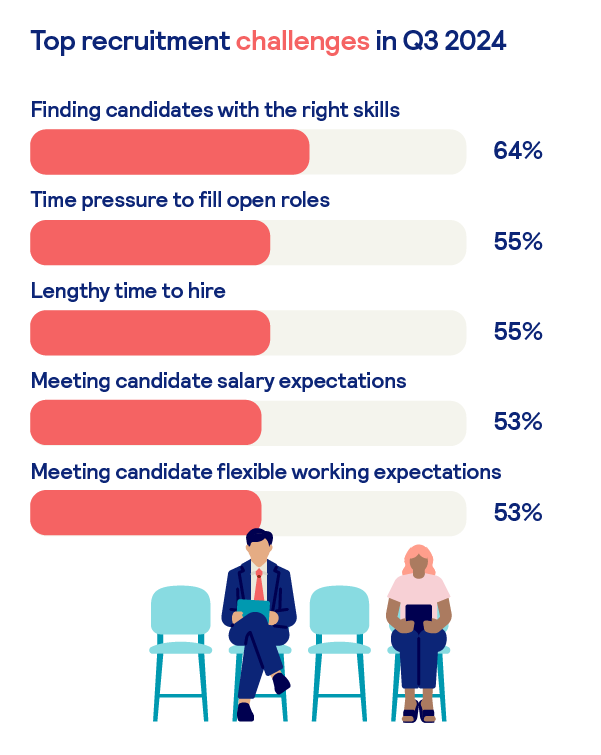
Interestingly, when it comes to tackling these challenges, only 46% of recruiters are using CV databases to source talent, with 28% missing out on this valuable resource.
Closer to home, another pressure point is resource-related: nearly half of recruiters (47%) say they don’t have enough time and resources to recruit effectively. On average, those working in talent acquisition are spending 7 hours per week on manual tasks like drafting job ads, sending emails, and managing internal systems—suggesting that more can be done to streamline and digitise the recruitment process.
Recruitment in Q4 2024 – Businesses focus on skilled talent
Only 68% of recruiters are confident in finding the people they need in Q4, a drop from 77% in Q3. However, as we move towards the end of the year, employers are still weighing up their recruitment plans.
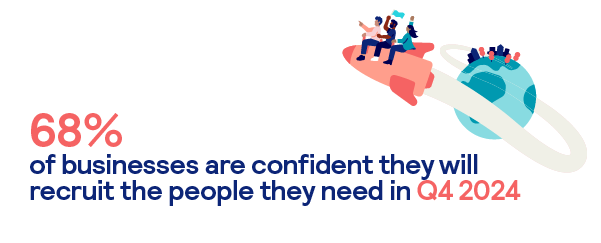
As it stands, only 23% of businesses expect to increase their recruitment in Q4, marking a further drop from the 27% in Q3. However, some companies are planning to strengthen their workforces through hiring temporary staff or freelancers (14%) or by focusing on hiring for specialist positions (17%).
Hiring confidence has also taken a hit, with just 68% of recruiters believing they will be able to successfully find the people they need in Q4, down from 77% in Q3 and 74% in Q1. The most confident sectors include IT & Telecoms (85%), Manufacturing (79%), Construction (78%), Logistics (78%), and Finance and Accounting (74%).
In terms of what employers are looking for, the most sought-after skills in Q4 include:
- Customer service and customer centricity (26%)
- Technical skills (25%)
- Soft skills (25%)
- Leadership and people management (25%)
This suggests that businesses are laser-focused on their immediate priorities—bringing in specialists, using temporary staff to fill gaps, and emphasising leadership and customer service—all to ensure they’re able to meet customer demands and hit their targets by year-end.
But, with the Autumn Budget around the corner, and the economy continuing to find its feet, this could be set to change as new opportunities present themselves.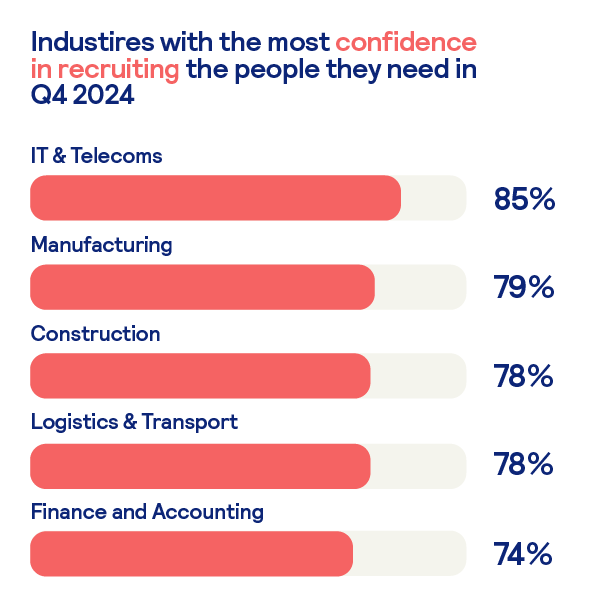
The productivity conundrum: A cycle of poor workplace productivity
When businesses struggle to fill skills gaps or find the right talent, they often find themselves stuck in a cycle of low productivity.
It’s a tough situation: without the right people in place, overall performance is bound to take a hit. Then, as team members rally round to pick up the slack, it causes stress, burnout, and more absences among employees—leading to yet another hit on productivity.
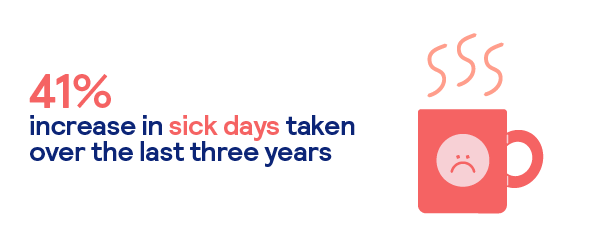
According to our research, almost 1 in 5 (17%) businesses believe that this dent in productivity negatively impacts their workplace culture and employee morale. With sick days increasing by 41% over the past three years and the number of holiday days taken rising by 31%, it’s clear that this cycle of poor productivity is in full swing.
Let’s explore in more detail.
Factors impacting workplace productivity
So, what’s contributing to low workplace productivity?
First off, over half (53%) of employers point to skills shortages and a lack of suitable candidates as their biggest hurdle.
But this creates a ripple effect, as employers then find themselves:
- Struggling to attract and retain high-quality talent (71%).
- Relying on temporary staff or overtime to fill gaps (69%).
- Having less time to spend on important projects and strategic planning (68%).
In short, without the right people on board, it’s tough to keep everything running smoothly.
On top of this, another significant challenge is inadequate budgets or resources, which 53% of employers say is affecting their productivity. When teams don’t have the tools or funding they need, it becomes difficult to meet goals, leading to frustration and lower morale.
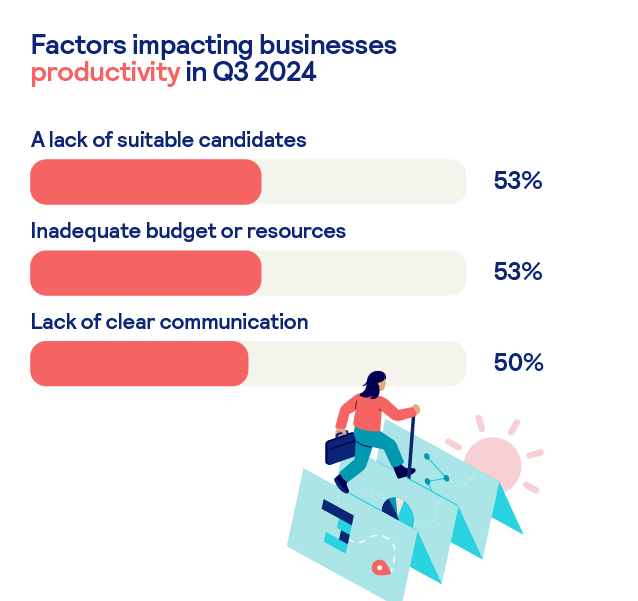
Finally, a lack of clear communication from leadership is an issue for 50% of businesses. When employees aren’t sure about the company’s direction or their specific roles, it can create confusion and misalignment, which only slows things down further.
The consequences of low productivity
Low productivity doesn’t just affect individual tasks; it can create a domino effect that impacts the entire business.
Over the last year, employers say that low productivity had a significant impact on their staff – with greater workload falling on remaining employees being the top one.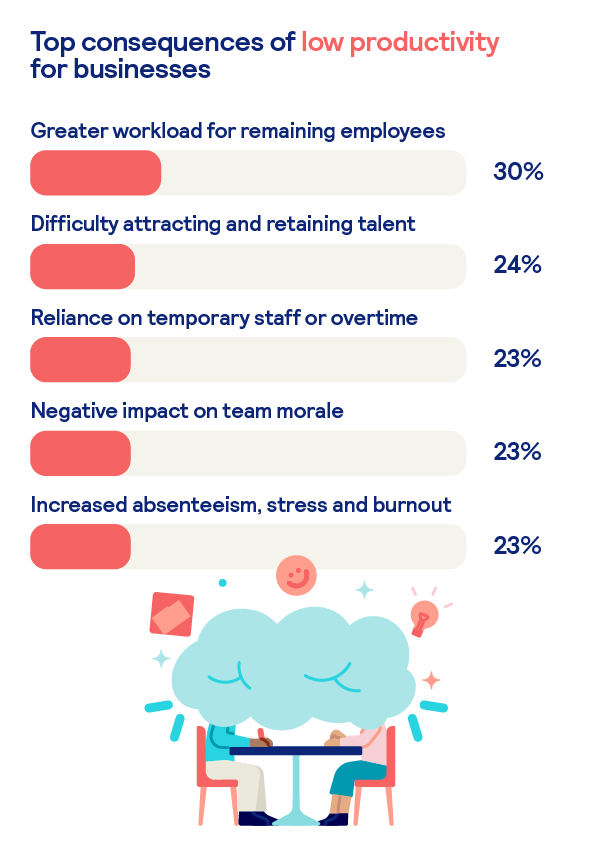
As these issues stack up, the cycle of low productivity continues, making it increasingly difficult for businesses to regain their footing.
Focus on: Productivity and mental health
When employees experience burnout due to their workload, their mental health inevitably suffers. Beyond caring for your team’s wellbeing, this significantly impacts your ability to retain top talent.
Our research shows that employers estimate 25% of staff turnover in the past year was linked to stress and burnout.
What’s more, 19% of those who left their jobs in the last three months did so for health-related reasons. This figure comes just behind those leaving for personal reasons like relocation or retirement (32%), or for better career opportunities elsewhere (29%).
As employers strive to maintain a productive workforce, prioritising mental health and employee wellbeing is key. By fostering a supportive environment, businesses can improve employee satisfaction, bolster staff retention, and in turn, boost their team’s overall productivity.
Step businesses are taking to address productivity
Business are increasingly aware of the need to tackle low productivity head-on.
To address this challenge, many are putting strategies in place to foster a more efficient and supportive work environment. Here are some of the key steps they’re taking.
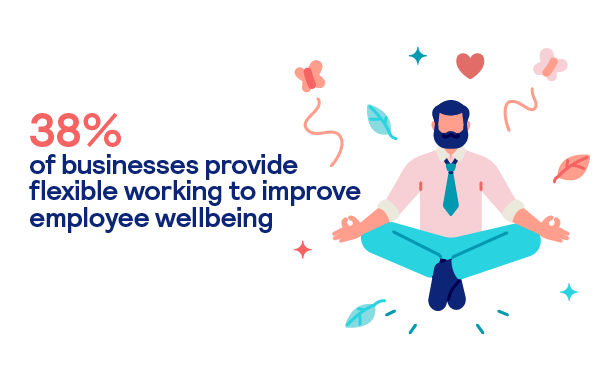
Promoting work-life balance
A growing number of employers are recognising how a healthy work-life balance can boost productivity. In fact, 28% of HR leaders believe offering flexible working options helps improve productivity, and 30% of businesses have already implemented it.
Given ongoing recruitment challenges, this strategy can also strengthen your employer brand. According to our Salary & Benefits Trends for 2024, flexible and hybrid working are now top priorities for candidates. In fact, 52% of workers said they wouldn’t apply to a job that doesn’t offer hybrid working.

By giving your team the flexibility to manage their schedules, you can reduce stress, improve job satisfaction, and ultimately create a more engaged and productive workforce.
Improving clarity and communication
Alarmingly, 50% of HR leaders believe that a lack of clarity from leadership is negatively impacting their team’s productivity. When employees don’t have consistent goals or clear strategies, it becomes difficult to prioritise and stay focused.
This is why 27% of HR leaders see improving communication and clarity from leadership as key to boosting productivity, with 26% already taking steps to address this issue
By fostering open lines of communication and aligning everyone with clear goals, you can drive engagement, empower employees, and improve overall productivity and performance.
- Drive engagement
- Empower employees
- Improve producutivity
- Enhance performance
Enhancing employee recognition and rewards
Recognising and rewarding employees for their hard work is another key strategy being used to boost productivity. Setting clear goals is one thing, but acknowledging achievements is crucial for keeping a motivated and dedicated team
Around 26% of HR leaders recommend investing in recognition and rewards, and 24% of employers have already taken action
When employees feel valued for their contributions, they’re more likely to take ownership of their work and strive for excellence. By regularly reviewing salaries and cultivating a culture of appreciation, you’ll build a more committed workforce eager to contribute to your company’s success.
Improving health and wellness programmes
Focusing on employee wellbeing is essential for reducing absenteeism and unlocking higher productivity
As it stands, 24% of HR leaders recommend improving health and wellness programmes, and 20% of employers are already taking steps to support their teams’ wellbeing
Private health insurance is also becoming an increasingly popular benefit for attracting top talent. In fact, our Salary and Benefit guides show that 24% of jobseekers are drawn to roles offering private health insurance, with a third (33%) willing to forgo a higher salary in order to get it.
By investing in comprehensive health and wellness initiatives, you demonstrate your commitment to your team’s welfare—helping to attract and retain talent, reduce absenteeism, and create a more vibrant, productive workplace.
Investing in learning and development
Whether it’s training courses, workshops, or mentoring, 27% of businesses believe that offering more learning and development (L&D) opportunities is a gamechanger in addressing low productivity.
Beyond unlocking your team’s potential, it also helps attract and retain ambitious talent. Our research shows that 68% of UK workers have changed jobs due to a lack of L&D opportunities, and nine in 10 want their employers to support their skills development.
Recognising this, many businesses are already taking action—45% of job adverts now highlight learning and development opportunities. By investing in L&D, you can equip your team with the tools they need to succeed for years to come.

Further reading
How to enhance learning and development at work
Totaljobs – Your hiring solution partner
Work with an industry-leading hiring solutions provider that understands your challenges and can help you find the skilled talent you need.
Part of the global recruitment technology company, The Stepstone Group, Totaljobs is a cutting-edge recruitment solutions partner whose goal is to find the right job for everyone.
Find the right people for your business by reaching wider talent pools, increasing your brand’s visibility, and maximising your hiring budget.
Explore articles
Receive the latest recruitment resources and
advice to boost your hiring
By providing us with your details you agree to our privacy policy and for us to keep you updated with the latest news, events,
and special offers from Totaljobs.



